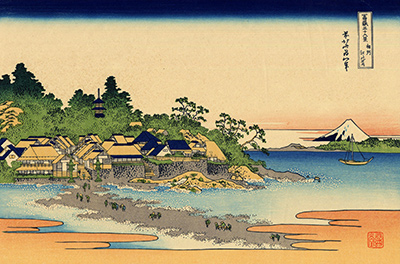Enoshima in Sagami Province or Sōshū Enoshima, is a print that is found in Katsushika Hokusai’s series Thirty-six Views of Mount Fuji also known as Fugaku sanjūrokkei. The iconic artist was born during the Edo period in October 1670 in Edo District and died in May 1849.
The print Enoshima in Sagami Province was produced in ca. 1830-32 during the Edo period in Japan and classified as a print. It was printed on a Polychrome woodblock print; ink and colour on paper medium with dimensions of 10 1/8 x 14 7/8 in. (25.7 x 37.8 cm). In the Enoshima in Sagami Province print Hokusai depicted the five-story pagoda at Ryukoji Temple that is located in a distant view of the forest of young leaves.
The worshipers who visit the Temple are walking along the sandbar during the low tide of the sea. There are various inns and souvenir shops portrayed along the shore. The Enoshima in Sagami Province expresses the sparkle foaming of the waves striking the beaches and rocks in an Ukiyo-e style woodblock.
Historians, artists, and printmakers were fascinated by the Japanese tradition that The Mount Fuji had some secret powers for immortality that they chose to come up with ways of preserving that myth. Katsushika Hokusai was one of the most passionate of them all with over thirty pseudonyms and regarded as one of the most respected painting artists of the Edo period.
Hokusai’s passion inspired the printing of the iconic series Thirty-six Views of Mount Fuji that became so popular to date. Although he had other names that represented his artistic prowess and various periods of his career, his surname Hokusai prevailed over the other Monikers. He started painting at an early age of four before transitioning from woodblock based paintings to landscape images that are representative of the culture of the people of Japan. Hokusai learned a few painting skills from his father who was a mirror-maker before joining the library and bookshop and later on in life the admission to the Tawaraya School.




